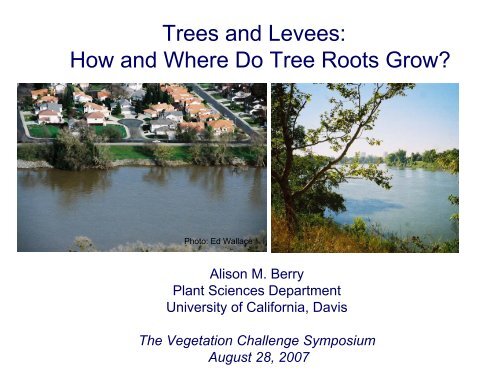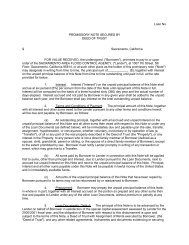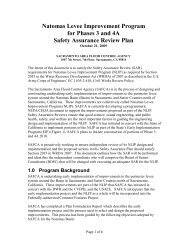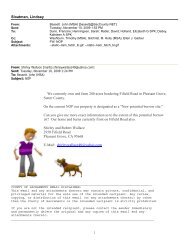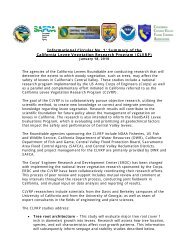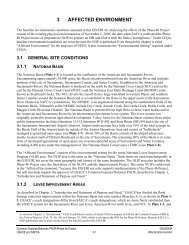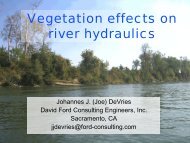Trees and Levees: How and Where Do Tree Roots Grow? - SAFCA
Trees and Levees: How and Where Do Tree Roots Grow? - SAFCA
Trees and Levees: How and Where Do Tree Roots Grow? - SAFCA
You also want an ePaper? Increase the reach of your titles
YUMPU automatically turns print PDFs into web optimized ePapers that Google loves.
<strong><strong>Tree</strong>s</strong> <strong>and</strong> <strong>Levees</strong>:<br />
<strong>How</strong> <strong>and</strong> <strong>Where</strong> <strong>Do</strong> <strong>Tree</strong> <strong>Roots</strong> <strong>Grow</strong>?<br />
Photo: Ed Wallace<br />
Alison M. Berry<br />
Plant Sciences Department<br />
University of California, Davis<br />
The Vegetation Challenge Symposium<br />
August 28, 2007
<strong>Tree</strong> <strong>Roots</strong> <strong>and</strong> <strong>Levees</strong>: Potential Risks<br />
Levee Seepage<br />
Windthrow <strong>and</strong> Surface Erosion<br />
1. “<strong>Roots</strong> 101”: <strong>How</strong> <strong>Tree</strong> Root Systems <strong>Grow</strong><br />
• Horizontally <strong>and</strong> vertically in the soil profile.<br />
• Opportunistically-- soil conditions.<br />
• Biomechanically-- whole-tree weight & stress.<br />
• Implications for tree failures.<br />
2. <strong>Do</strong> <strong>Tree</strong> <strong>Roots</strong> <strong>Grow</strong> Into <strong>Levees</strong>?<br />
• Mayhew Levee Trenching Project<br />
3. Conclusions & Questions
<strong>Tree</strong> Root Systems – Classic Concepts<br />
•<strong>Tree</strong> roots grow horizontally more than vertically –most conditions.<br />
•Root systems can extend >2X the diameter of the canopy.<br />
•80% of the root system is in the upper 1 meter (3-4 ft) of soil.<br />
Root architecture: combination of 3 major woody systems<br />
•Heart roots<br />
•Horizontal roots<br />
•Sinker roots
<strong>Roots</strong> grow opportunistically<br />
•Moisture & nutrients<br />
•Aeration<br />
•Mechanical impedance<br />
•Other soil properties<br />
•Surface 1-2 ft best conditions for growth<br />
40 in.<br />
Soil surface<br />
Lyford 1980<br />
Excavated root distribution pattern (Red oak)
Common tree structural root architecture (mature ash)<br />
40 inches
<strong>Tree</strong> species characteristics, soil conditions can <br />
different architectures<br />
photo: Molly Ferrell<br />
Cottonwoods (Cosumnes R.)<br />
heart roots, strongly horizontal roots & sinker roots
Soil texture, depth can influence root architecture<br />
Deep, s<strong>and</strong>y soil<br />
•poor mechanical stability.<br />
•excessively well-drained.<br />
<strong>Roots</strong> grow downwards<br />
•do not spread laterally.<br />
•likely follow moisture gradients<br />
downward.<br />
Valley oak (dead) root system excavated<br />
in s<strong>and</strong>y levee, Sacramento River<br />
D. Gray, D. Shields et al. 1992
Surface root plate – fallen <strong>Do</strong>uglas fir<br />
Shallow soils<br />
(hardpan, claypan)<br />
•high mechanical<br />
impedance.<br />
•poor aeration, probably<br />
saturated.<br />
<strong>Roots</strong> spread laterally<br />
•Dense but shallow “root plate”.<br />
•poor tree stability.
Soil strength: saturated soil<br />
Whole tree effects: crown asymmetry<br />
Root plate <strong>and</strong> vertical roots – fallen pine
<strong>Tree</strong> <strong>Roots</strong> <strong>Grow</strong> Biomechanically<br />
Individual roots respond to stresses with compensation<br />
“I-beam”= root strength<br />
crown<br />
asymmetry,<br />
sun exposure,<br />
slope, soil<br />
instability<br />
Buttress root<br />
(Steeply tapered roots)<br />
Whole-tree weight distribution also<br />
produces compensating architecture
Uprooting is a major concern near <strong>and</strong> on levees<br />
Uprooting<br />
damage<br />
potential:<br />
New Orleans<br />
Different species/conditions/root architectures<br />
may produce different damage levels:<br />
Shallow root plates shallow“divot”<br />
Aggressive root systems severe damage.<br />
Steeply tapered roots fracturing.
Root Turnover <strong>and</strong> “Channels”: <strong>Do</strong> dead<br />
roots pose threats?<br />
We need more information on dead woody<br />
root persistence <strong>and</strong> turnover.<br />
Large-diameter (2”) <strong>Do</strong>uglas fir roots persist<br />
for 50 years or more. But hardwood roots<br />
may decay more rapidly.<br />
In either case, resulting organic material is<br />
likely to be recolonized quickly by other roots<br />
(opportunism).<br />
<strong>How</strong>ever, large-scale tree removal does<br />
result in increased soil destabilization.
2. <strong>Where</strong> <strong>Do</strong> <strong>Tree</strong> <strong>Roots</strong> <strong>Grow</strong>?<br />
Key question: <strong>Do</strong> large woody roots grow<br />
into or under levees, <strong>and</strong> cause increased<br />
seepage?<br />
Excavation is still the best way to find out.
Mayhew Levee Trench Profile Project<br />
trees<br />
300 ft berm<br />
USACE, Sacramento District<br />
Photo: Scotty Mahlum, USACE<br />
•Levee constructed in<br />
1970s (non-USACE)<br />
•Residential homes<br />
•300-ft berm<br />
•Levee to be regraded
Project<br />
Photo: Scotty Mahlum, USACE<br />
•3 mature oak trees.<br />
•14’-30’ from levee toe<br />
(river side).<br />
•Trench-profile method<br />
used.<br />
•Trenches 4’ deep,<br />
•Parallel to levee.<br />
•Length of tree crown<br />
shown =56’.
Levee<br />
Trench 4’ deep<br />
Photo: Scotty Mahlum, USACE
Big Project!<br />
USACE<br />
Alison Berry<br />
Vic Claassen<br />
John Lichter<br />
Molly Ferrell<br />
Photo: Scotty Mahlum, USACE<br />
•EDAW<br />
•Kleinfelder, Inc.<br />
•Hart Restoration<br />
•Research crew (UC<br />
Davis, Sac State)
0<br />
1<br />
2<br />
3<br />
4<br />
Root Trench Profile Excavation –Valley Oak #1<br />
Mayhew Levee (Sacramento, CA)<br />
Horizontal (ft)<br />
48<br />
47<br />
46<br />
45<br />
44<br />
43<br />
42<br />
41<br />
23<br />
22<br />
21<br />
20<br />
19<br />
18<br />
17<br />
16<br />
15<br />
14<br />
13<br />
12<br />
11<br />
10<br />
9<br />
38<br />
37<br />
36<br />
35<br />
34<br />
33<br />
32<br />
31<br />
30<br />
29<br />
28<br />
27<br />
26<br />
25<br />
24<br />
40<br />
39<br />
<strong>Roots</strong>
1.2<br />
1.4<br />
1.6<br />
1.8<br />
S<strong>and</strong>y loam<br />
Critical bulk density≈ 1.65<br />
Mayhew levee toe<br />
bulk density at 2’<br />
depth = 1.63<br />
<strong>Roots</strong><br />
basically do<br />
not grow into<br />
this<br />
compacted<br />
zone.
One scoop: ≥2” diameter roots were below 4-ft trench floor<br />
Levee side<br />
Large (2”)<br />
root at ~4-5 ft<br />
Trench<br />
floor<br />
<strong>Tree</strong> side<br />
(To river)<br />
Photo: Scotty Mahlum, USACE
“Virtual Trenches”: Ground Penetrating Radar (GPR)<br />
for further corroboration<br />
John Lichter<br />
making GPR<br />
transect scans<br />
Photo: Scotty Mahlum, USACE
Transect Design Sketch<br />
5 transects,<br />
~3 ft apart<br />
Center<br />
transect:<br />
where<br />
excavated<br />
trench profile<br />
was located.
PRELIMINARY<br />
DATA<br />
Antenna detects roots >1” diameter, up to 8-10’ depth<br />
GPR confirms trench findings: large roots at 4’-6’ depth<br />
-1ft<br />
-3ft<br />
-5ft<br />
The 1’ – 3.5’ zone<br />
is featureless,<br />
indicating<br />
homogeneous fill<br />
soil.<br />
This Text<br />
T. Mucciardi<br />
T. Mucciardi
GPR Data: Overhead View of Transects<br />
Depth range (corrected): 41” – 72”<br />
Toe<br />
<strong>Tree</strong><br />
Levee<br />
Slope<br />
T. Mucciardi
TAKE HOME MESSAGES<br />
1. <strong>Roots</strong> could be growing under the Mayhew levee,<br />
from nearby trees.<br />
2. <strong>How</strong>ever, roots avoided well-compacted fill:<br />
keyhole trenches, slurry walls, deep protection<br />
trenches may be effective.<br />
3. There are many unanswered questions. We need<br />
more information, combining trench excavation,<br />
GPR <strong>and</strong> other methods, to determine the real<br />
picture of roots <strong>and</strong> levees.<br />
4. Biomechanical & root-shoot considerations:<br />
Pruning to control crown symmetry <strong>and</strong> size could<br />
reduce risk of root damage considerably.


